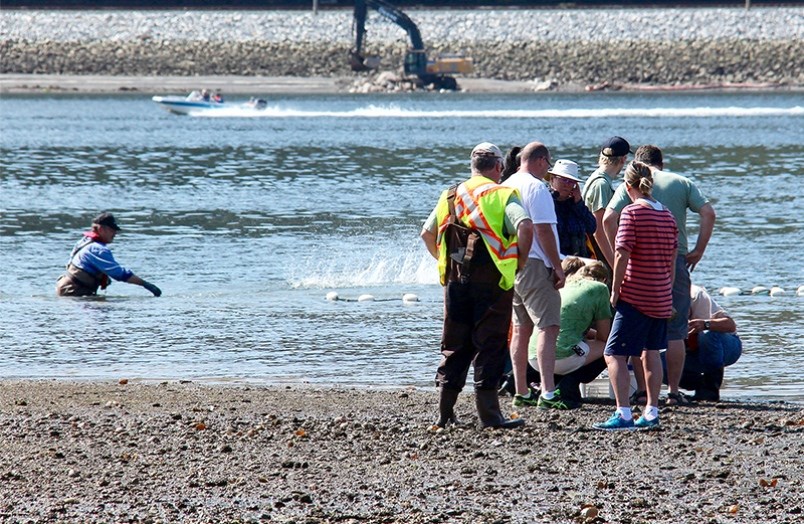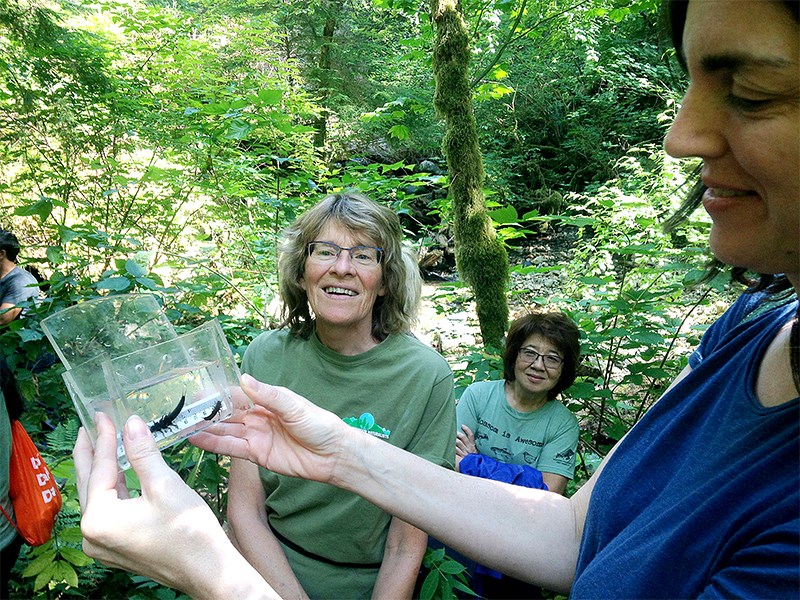Mossom Creek may not be a Garden of Eden, but for hundreds of plants, animals and insects, it’s home.
And thanks to the Burrard Inlet Marine Enhancement Society (BIMES) and its newly released BioBlitz report, we now know more about them.
The 24-hour count that took place Aug. 18 and 19 in Mossom Creek and nearby North Schoolhouse Creek watersheds in Port Moody found 377 species of plants, animals, fish, birds, amphibians and insects, including frogs that are a species of concern and a tiny moss (Roell’s Brotherella) that needs federal protection or it will disappear.
Flowing into Burrard Inlet, Mossom Creek, on Port Moody’s north shore, has been logged many times but still sustains a forested landscape that provides paths for animals such as mule deer, cougar and black bears. It has even hosted predators such as wolverines, a rarely observed species that usually sticks to the mountains.
Pam Zevit, a professional biologist who works with the South Coast Conservation Program, compiled the data for BIMES, said she was impressed the volunteers who participated as well as with the diversity of species found, especially since the count was done during a dry summer period when many creatures would be hidden.
“I’m hoping that the information — it’s really designed for the local community for BIMES and Mossom Creek folks — to use that as a foundation piece for understanding the watershed a little better.”

The report comes at a time a developer is looking to find the best way to utilize its land in the area, which includes the Mossom Creek watershed.
Brilliant Circle Group (BCG) is currently developing a vision for the 250-acre Ioco lands and contributed to the cost of the BioBlitz.
Ruth Foster, Mossom hatchery’s co-founder, said BCG’s $5,000 contribution indicates the company is keenly interested in the sensitive local ecosystem, and will be a positive steward.
“The very fact they are open to the exploration — some [identified species] might be species at risk, could affect their ability to develop the watershed — is very commendable.”
(Other groups that contributed include Toronto Dominion Friends of the Environment, which gave $5,000, and $9,000 from a Canada 150 grant through the Port Moody Foundation.)
Foster told The Tri-City News she hopes the research — soon to be presented to Port Moody and Anmore village councils, and already available online at www.mossomcreek.org/bioblitz — will contribute to a greater understanding of the watershed while providing inspiration to other groups to conduct similar species counts in their creeks.
“I would certainly encourage other groups to undertake this,” she said. “It was very rewarding to see the enthusiasm of the public that came, that participated in the walks and on the teams for the scientists.”
As volunteers identified plants, conducted beach seines in the ocean to study marine life and peered into the creek to count bugs, an inventory of a richly diverse environment came to life.
Zevit, who has coordinated BioBlitzes in other regions, says it’s as important to study the tiny creatures as it is to marvel at the beautiful mammals, such as bears and deer, that travel the paths around Mossom.
“It’s all about an intact and complete watershed,” Zevit told The Tri-City News. “We need the greatest biodiversity possible, and if we don’t record and notice these small little things, they could disappear without anyone noticing."
The hope is that developers, municipal councils and senior levels of government will pay attention to changes identified through BioBlitzes and make laws or initiate projects, such as installing bat boxes, to protect endangered species.
Among the recommendations in the report is that the Mossom BioBlitz will be used as a benchmark system to measure local biodiversity in other Port Moody, Anmore and Belcarra watersheds, and possibly other areas of Metro Vancouver, such as North and West Vancouver.



